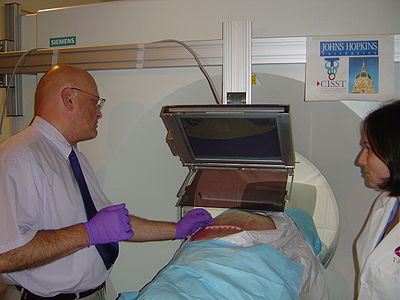DBP2:Queens:PerkStation
Back to Queens DBP 2
PERK Station (Image overlay to perform/train image-guided needle interventions)
Objective
The objective of this project (PERK Station) is to develop a end-to-end solution implemented as a Slicer 3 module to assist in performing/training for image-guided percutaneous needle interventions. The software, along-with its hardware, overlays the image (CT/MR) acquired on the patient/phantom. The physician/trainee looks at the patient/phantom through a semi transparent mirror showing the image overlay and the CT/MR image appears to be floating inside the body with the correct size and position, as if the physician/trainee had 2D ‘X-ray vision’.
Description
The PERK Station comprises of image overlay, laser overlay, and standard tracked freehand navigation in a single suite. The end-to-end solution software module along-with its hardware, operates in clinical environment, or on the PERK Station training hardware. Image overlay works by a secondary monitor mounted with a semi-transparent mirror at 45 degree angle. Thus, the image displayed on the secondary monitor, gets projected on the mirror, and when seen through the mirror, the image appears to be floating on the patient/phantom.
(Note: To use training mode, developed as practical instruction tool for high school students, use revision 5772.)
The software enables to perform image-guided percutaneous needle biopsies. The workflow consists of four steps:
- Calibration: To register the image overlay device with patient/phantom lying on scanner table. In this stage, the software sends the image to the secondary device, in correct physical dimensions. The software enables the user to translate/rotate the image as seen through the mirror, so that it aligns with the fiducials mounted/strapped on patient/phantom to achieve registration. This fiducial alignment achieves in-plane registration. For registration in z-plane, the image projection plane should be coincident with the laser-guide plane, which is also the plane of acquisition.
- Planning: In this step, the entry and target points are given by mouse-clicks. The software calculates the insertion angle w.r.t vertical and insertion depth.
- Insertion: The software overlays the needle guide on the secondary monitor/mirror to assist the physician/user to perform the intervention. Further depth perception lines appear in gradations of 10mms to help the physician to insert the needle at correct depth.
- Validation: If the needle insertion is needed to be validated, the user acquires a validation image with needle inside patient/phantom. The validation volume/image is loaded to scene. The user can give the actual needle entry and end points to get error calculations.
Schedule
- 08/01/2009: Current status: All the core functionalities are implemented in a dynamically loadable Slicer module (one does not need to modify any of the Slicer code to use this module)
- 09/24/2009: Demonstration and tutorial: Demonstrated and provide one-on-one tutorials about the Perk Station on the MICCAI 2009 Conference (London, UK)
- 10/30/2009: Oblique slice support: Support needle insertion planning in any slice orientation.
- 11/30/2009: Software review: Review the software in terms of compliance to Slicer's interactive module architecture (with engineering core members).
Current deployment/usage:
- Clinical mode: The software has been delivered to team at Johns Hopkins University, Baltimore. It is currently being used in phantom and cadaver trials.
- Training mode: The software and hardware (designed and developed by Paweena U-Thainual and Iulian) integrated system has debuted as a part of Fall course at Queens' University in School of Computing for undergrad teaching taught by Dr Gabor Fichtinger.
Software source code:
Available on the NA-MIC Sandbox - access PerkStationModule
Tutorial
- Perk Station: PerkStationSlicerTutorial New
- Perk Station tutorial dataset: PerkStationTutorialDataset.zip New
- Perk Station hardware assembly instructions: coming soon...
Publications
- Vikal, S., P. U-Thainual, J. Carrino, I. Iordachita, G. Fischer, and G. Fichtinger, "Perk Station-Percutaneous surgery training and performance measurement platform", Computerized Medical Imaging and Graphics, June 2009.
- U-Thainual, P., G. Fischer, I. Iordachita, S. Vikal, and G. Fichtinger, "The Perk Station: Systems design for percutaneous intervention training suite", Procedings IEEE International Conference on Robotics and Biomimetics ROBIO 2009, pp. 1693–1697, 22–25 Feb, 2009.
- U-Thainual, P., I. Iordachita, S. Vikal, and G. Fichtinger, "Teaching Aid for Computer-Assisted Surgery", Eastern Ontario Symposium for Educational Technology, 2009.
- U-Thainual, P., I. Iordachita, and G. Fichtinger, "The Perk Station: Design of a percutaneous intervention training suite", 20th International Conference of the Society for Medical Innovation and Technology (SMIT), Vienna, Austria, August 28-31, pp. 148-153, 08/2008.
- Ahmidi, N., P. U-Thainual, S. Vikal, P. Mousavi, I. Iordachita, and G. Fichtinger, "A System for Performance Analysis of Surgeon Dexterity in Percutaneous Needle-based Interventions", 7th Imaging Symposium of the Imaging Network of Ontario, 2008.
- U-Thainual, P., G. Fischer, J. Carrino, G. Fichtinger, and I. Iordachita, "MR/CT Percutaneous Intervention Training Suite", 7th International Symposium on Interventional MRI, pp. 81-85, 2008.
- U-Thainual, P., S. Vikal, I. Iordachita, and G. Fichtinger, "The Perk Station: Portable training station for percutaneous interventions", Orthopaedic Care Conference, 2008.
Team
- PI: Gabor Fichtinger, Queen’s University (gabor at cs.queensu.ca)
- Hardware: Paweena U-Thainual, Queen's University(paweena at cs.queensu.ca), Iulian Iordachita, Johns Hopkins University (iordachita at jhu.edu)
- Software Engineer: Tamas Ungi (ungi at cs. queensu.ca), Andras Lasso (lasso at cs. queensu.ca), Siddharth Vikal, Queen’s University
- Queens Software Engineer Support: Csaba Csoma, Johns Hopkins University (csoma at jhu.edu)
- NA-MIC Engineering Contact: Katie Hayes, MSc, Brigham and Women's Hospital (hayes at bwh.harvard.edu)
- Host Institutes: Queen's University & Johns Hopkins University
